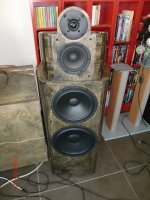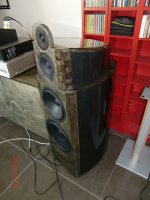I've been posting about my latest speaker-building escapades in other threads for a while now so I thought it might be a good time to consolidate and start my own thread.
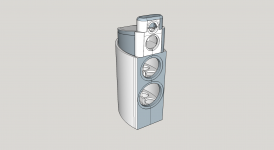
TLDR: 4-way with 26W discovery, 22W discovery, SATORI mw13p-8, SB26ADC. Najda FIR crossover, 1023 taps per channel. Crossover points ~120Hz, 200-400Hz, 2.2-2.8 KHz.
The name: Achilles
In this hobby we're continually looking for the next best or the weakest link in our systems (or even just trying new things for the fun of it). Since no system is ever perfect for everyone and even my own taste can change I think it's a fitting name. Also since I can become quite obsessed once my mind starts churning it sometimes becomes my Achilles heel 🙂.
Design goals:
1) Main living room system, it should sound good everywhere in the living room/open kitchen. It should sound perfect on every seat of the 3 seat couch in front of the system. 70% of listening (not critical listening) takes place more then 60° of axis.
2) In order to accomplish 1) I need wide dispersion and smooth power respons.
3) I like bass, lots of it. I prefer it to be as tight as possible and love the chest thump you get at live concerts. All systems were I really liked the bass had only 1 thing in common, they were closed. So no vents.
The background:
3 years ago after lurking for quite a while I first registered here for the build of my first sub.
http://www.diyaudio.com/forums/subwoofers/233438-dual-opposed-shiva-sub-inuke1000dsp.html
I was very happy with it at the time but 1 year later I found some 15" Beyma subwoofer drivers for 75€ each at a public sale (~300-350€ retail). And built myself the monster I'm still using for subwoofer/tv stand.
http://www.diyaudio.com/forums/subwoofers/268803-15-plenum-ppsl.html
After my mother heard the monster (hands still clenching the couch) she asked me how long it would take to build her one so I built a new similar looking PPSL cab for the Shivas and gave it to her.
I never seriously looked into non-sub speakers because I never had the time to learn everything properly and usually set the bar pretty high for myself. At this point however I was unemployed and bored so I thought why not start learning. I have a PhD in chemistry (optics and nanoparticles) so given time I was quite optimistic about getting good results.
In the spirit of learning to crawl before trying to run I did some cabinet and damping experiments with the monitor audio silvers I had. XRK was doing some cool things with the nautaloss and foamcore so I mimicked the design in MDF to see (hear) if it would work as well.
http://www.diyaudio.com/forums/multi-way/278622-2-new-cabinets-monitor-audio-silver-s2-test.html
After this I felt confident enough to actually buy drivers and try to build something myself.
The plan:
I didn't want a line array with 10" or 12" mids in my living room and after some discussion with my SO (and designing a beautifully curved cabinet in sketchup 😀) I found I could get away with up to a 10" for woofer duties. I'm a big fan of Troels's site and after reading about the discovery 4 I settled on something similar for the basscab. It reminds me a bit of the dub soundsystems were they use 18" woofers in a severely distorting FLH and 12" closed kickbins for the chest thump.
I also thought the classic 3-way looked very interesting and the 10F was one of the best drivers in XRKs driver roundup. It is also usable for very divers purposes so wouldn't be "lost" if I decided to change later. I was also having doubts about the classic SS midwoofer used in the discovery 4. It is expensive, the non-treated paper looks weird and I read some things about QC difficulties in making these cones.
But what about the crossover? I wanted to learn a lot and change things regularly so buying coils and caps every time didn't seem like a good idea. I settled on the Najda DSP because it is basically a minidsp HD 2x8 and nanodigi all in one so I could experiment with both IIR and FIR filters. I was also seriously put off by all the discussions about esoteric and ridiculously expensive caps (the part cost of the discovery 4 crossover is about the same as a fully built Najda).
So step 1 towards the final achilles was to make a classic 3-way, using the 22W discovery in a basscab were I could add a 10" 26W discovery later. I also changed the tweeter to a ND25FA because I was interested in hearing a soft dome, it was cheap and I was afraid of killing at least 1 tweeter in my first build (I did 😱).
Step 2 was to add and integrate the 10" 26W discovery
In step 3 I changed the tweeter for a SB26ADC. It has very wide dispersion and ridiculously low THD down to 1KHz.
In step 4 (and hopefully the last driver change for a while 🙄) I want to change the 10F for a SATORI mw13p-8. I didn't want to make a 2-way + basscab like the disc4 anymore, I really like the sound of the 3-way and I think the higher crossover point between mid and tweet and good dispersion of the mid is important in this regard. At the moment I'm output limited by the 10F so I wanted something with higher output. Beaming issues preclude 6.5" drivers. I considered going MTM with the 10F but lobing issues made me reconsider. Initially I settled on the 5.25" revelator but when the 5" satori came out I changed my mind. It's a bit smaller then the revelator (70cm² vs 100cm²) but has sufficient output and I can cross a bit higher, it is also a lot cheaper (107€ vs 180€) In comparison to the 10F I get 4x power handling, 2x SD and 2x xmax.
I ordered the Satori yesterday and it should arrive sometime next week. Until then I'll post some more pics and measurements of steps 1 through 3 😎

TLDR: 4-way with 26W discovery, 22W discovery, SATORI mw13p-8, SB26ADC. Najda FIR crossover, 1023 taps per channel. Crossover points ~120Hz, 200-400Hz, 2.2-2.8 KHz.
The name: Achilles
In this hobby we're continually looking for the next best or the weakest link in our systems (or even just trying new things for the fun of it). Since no system is ever perfect for everyone and even my own taste can change I think it's a fitting name. Also since I can become quite obsessed once my mind starts churning it sometimes becomes my Achilles heel 🙂.
Design goals:
1) Main living room system, it should sound good everywhere in the living room/open kitchen. It should sound perfect on every seat of the 3 seat couch in front of the system. 70% of listening (not critical listening) takes place more then 60° of axis.
2) In order to accomplish 1) I need wide dispersion and smooth power respons.
3) I like bass, lots of it. I prefer it to be as tight as possible and love the chest thump you get at live concerts. All systems were I really liked the bass had only 1 thing in common, they were closed. So no vents.
The background:
3 years ago after lurking for quite a while I first registered here for the build of my first sub.
http://www.diyaudio.com/forums/subwoofers/233438-dual-opposed-shiva-sub-inuke1000dsp.html
I was very happy with it at the time but 1 year later I found some 15" Beyma subwoofer drivers for 75€ each at a public sale (~300-350€ retail). And built myself the monster I'm still using for subwoofer/tv stand.
http://www.diyaudio.com/forums/subwoofers/268803-15-plenum-ppsl.html
After my mother heard the monster (hands still clenching the couch) she asked me how long it would take to build her one so I built a new similar looking PPSL cab for the Shivas and gave it to her.
I never seriously looked into non-sub speakers because I never had the time to learn everything properly and usually set the bar pretty high for myself. At this point however I was unemployed and bored so I thought why not start learning. I have a PhD in chemistry (optics and nanoparticles) so given time I was quite optimistic about getting good results.
In the spirit of learning to crawl before trying to run I did some cabinet and damping experiments with the monitor audio silvers I had. XRK was doing some cool things with the nautaloss and foamcore so I mimicked the design in MDF to see (hear) if it would work as well.
http://www.diyaudio.com/forums/multi-way/278622-2-new-cabinets-monitor-audio-silver-s2-test.html
After this I felt confident enough to actually buy drivers and try to build something myself.
The plan:
I didn't want a line array with 10" or 12" mids in my living room and after some discussion with my SO (and designing a beautifully curved cabinet in sketchup 😀) I found I could get away with up to a 10" for woofer duties. I'm a big fan of Troels's site and after reading about the discovery 4 I settled on something similar for the basscab. It reminds me a bit of the dub soundsystems were they use 18" woofers in a severely distorting FLH and 12" closed kickbins for the chest thump.
I also thought the classic 3-way looked very interesting and the 10F was one of the best drivers in XRKs driver roundup. It is also usable for very divers purposes so wouldn't be "lost" if I decided to change later. I was also having doubts about the classic SS midwoofer used in the discovery 4. It is expensive, the non-treated paper looks weird and I read some things about QC difficulties in making these cones.
But what about the crossover? I wanted to learn a lot and change things regularly so buying coils and caps every time didn't seem like a good idea. I settled on the Najda DSP because it is basically a minidsp HD 2x8 and nanodigi all in one so I could experiment with both IIR and FIR filters. I was also seriously put off by all the discussions about esoteric and ridiculously expensive caps (the part cost of the discovery 4 crossover is about the same as a fully built Najda).
So step 1 towards the final achilles was to make a classic 3-way, using the 22W discovery in a basscab were I could add a 10" 26W discovery later. I also changed the tweeter to a ND25FA because I was interested in hearing a soft dome, it was cheap and I was afraid of killing at least 1 tweeter in my first build (I did 😱).
Step 2 was to add and integrate the 10" 26W discovery
In step 3 I changed the tweeter for a SB26ADC. It has very wide dispersion and ridiculously low THD down to 1KHz.
In step 4 (and hopefully the last driver change for a while 🙄) I want to change the 10F for a SATORI mw13p-8. I didn't want to make a 2-way + basscab like the disc4 anymore, I really like the sound of the 3-way and I think the higher crossover point between mid and tweet and good dispersion of the mid is important in this regard. At the moment I'm output limited by the 10F so I wanted something with higher output. Beaming issues preclude 6.5" drivers. I considered going MTM with the 10F but lobing issues made me reconsider. Initially I settled on the 5.25" revelator but when the 5" satori came out I changed my mind. It's a bit smaller then the revelator (70cm² vs 100cm²) but has sufficient output and I can cross a bit higher, it is also a lot cheaper (107€ vs 180€) In comparison to the 10F I get 4x power handling, 2x SD and 2x xmax.
I ordered the Satori yesterday and it should arrive sometime next week. Until then I'll post some more pics and measurements of steps 1 through 3 😎
STEP 1
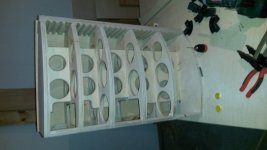
Basscab top, bottom and skeleton made out of 18mm baltic birch plywood. Side made with 4 laminations of 6mm "bendable ply".
I kept part of the cutouts for the bracing and use them to block the holes again, this way I can alter the internal volume. Top part is 20L, mid about 35L, bottom about 15L
The mid cabinet is 18mm MDF in a dagger-like shape open backed. Bitumen (cheap roofing) glued to all internal walls, 1cm felt glued to bitumen, fiberglass stuffing in basscab (quite a lot ~60% fill), a bit of sheepwool to the sides of the midcab so you can still see straight through.
I experimented with different crossovers starting with LR2 mimicking Troels's design. After that I tried the Harsch before going all-in with FIR crossovers.
Frequency respons
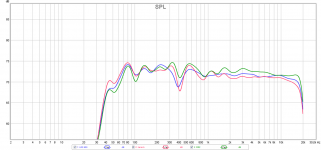
Phase
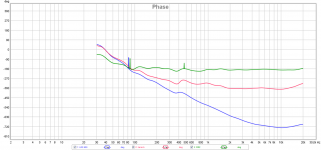
STEP
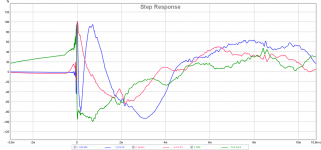
Before painting

Finished
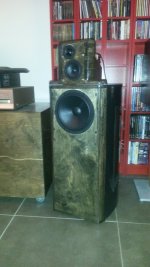
The most important and lasting impression when changing from the monitor audios to the classic 3-way for me is still the sound of a saxophone. I really didn't like sax music all that much before (I also had some B&W 604S3 in the past) now I almost can't get enough of it, some voices also really sound much better (roger waters, Benn Lee Jordan,...). Pretty much everything is better but I never expected a speaker to actually change my taste in music.

Basscab top, bottom and skeleton made out of 18mm baltic birch plywood. Side made with 4 laminations of 6mm "bendable ply".
I kept part of the cutouts for the bracing and use them to block the holes again, this way I can alter the internal volume. Top part is 20L, mid about 35L, bottom about 15L
The mid cabinet is 18mm MDF in a dagger-like shape open backed. Bitumen (cheap roofing) glued to all internal walls, 1cm felt glued to bitumen, fiberglass stuffing in basscab (quite a lot ~60% fill), a bit of sheepwool to the sides of the midcab so you can still see straight through.
I experimented with different crossovers starting with LR2 mimicking Troels's design. After that I tried the Harsch before going all-in with FIR crossovers.
Frequency respons

Phase

STEP

Before painting

Finished

The most important and lasting impression when changing from the monitor audios to the classic 3-way for me is still the sound of a saxophone. I really didn't like sax music all that much before (I also had some B&W 604S3 in the past) now I almost can't get enough of it, some voices also really sound much better (roger waters, Benn Lee Jordan,...). Pretty much everything is better but I never expected a speaker to actually change my taste in music.
Last edited:
Sneak preview
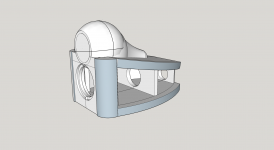
I allready finished the midcab for the satori, still need to do the baffle, damping and speaker plugs.
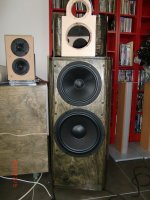
For the midcab I went all out. I made an inner box out of 6mm ply, glued bitumen (roofing) on the inside with floortack, on the outside with TEC7. Then I glued 3x 6mm ply to the sides (first layer TEC7, 2nd and 3rd with PVA glue) and 18mm baltic birch to the top and bottom. So starting from inside you have bitumen, floor tack, 6mm ply, TEC7, Bitumen, TEC7, 18mm ply. If that doesn't get me some CLD action I don't know what will.
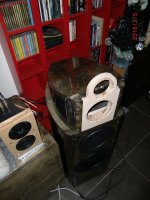
The front baffle is made of 2 parts, the unpainted piece of 18mm baltic birch with the driver cutouts will be screwed in the rounded baffle which is only glued to the inner box, no physical contact anywhere between driver, baffle and outer box. Internal volume is about 7-8L it is also open in the back (60mm dia)
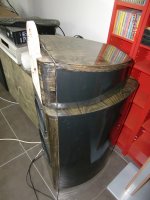
I'm not sure how I'm going to make the "tweeter head", I want it to look something like this:
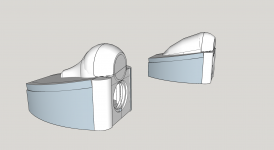
But I'm not good enough to shape this manually out of wood or foam, the current plan is to use some styrofoam eggs as a base shape and work up from there. I have some polyester left from another project I could use to make it more sturdy and to allow for a nice paint coating. If anyone has other ideas to do this I'm all ears.
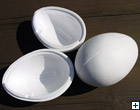

I allready finished the midcab for the satori, still need to do the baffle, damping and speaker plugs.

For the midcab I went all out. I made an inner box out of 6mm ply, glued bitumen (roofing) on the inside with floortack, on the outside with TEC7. Then I glued 3x 6mm ply to the sides (first layer TEC7, 2nd and 3rd with PVA glue) and 18mm baltic birch to the top and bottom. So starting from inside you have bitumen, floor tack, 6mm ply, TEC7, Bitumen, TEC7, 18mm ply. If that doesn't get me some CLD action I don't know what will.

The front baffle is made of 2 parts, the unpainted piece of 18mm baltic birch with the driver cutouts will be screwed in the rounded baffle which is only glued to the inner box, no physical contact anywhere between driver, baffle and outer box. Internal volume is about 7-8L it is also open in the back (60mm dia)

I'm not sure how I'm going to make the "tweeter head", I want it to look something like this:

But I'm not good enough to shape this manually out of wood or foam, the current plan is to use some styrofoam eggs as a base shape and work up from there. I have some polyester left from another project I could use to make it more sturdy and to allow for a nice paint coating. If anyone has other ideas to do this I'm all ears.

Last edited:
STEP 2
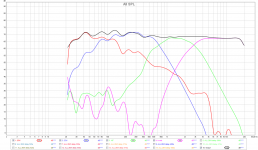
Integration of the 26W was a lot harder then I expected. There are 2 reasons for this:
1) Getting good measurement data for 30Hz-200Hz in room isn't easy, not for the minphase driver output I need for Rephase nor for checking the result of the crossover.
2) 1023 taps is barely enough for a LR2 at 100Hz, steeper slopes are not possible while maintaining phase linearity.
Due to the above and bafflestep, the 26W is only 20dB down at 1KHz. There are a number of possible solutions for this, none of them really good I think.
1) Put a coil in series with the 26W and go for a hybrid FIR-analogue crossover, seems a bit ballsy but maybe.
2) I can put an additional FIR crossover over left and right channel to decrease the highs overall and boost an equivalent amount in the relevant driver channels. But then I lose bits and resolution, and it won't be the best example of proper gain structure. Gain structure is already pretty bad since I'm using the pre-out of my denon 3806 to feed Najda.
In any case, I'll consider this to be Achilles's first heel 😉
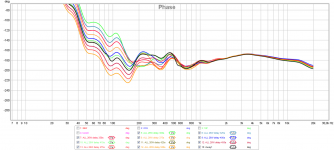
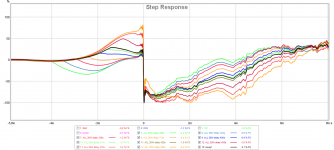
Another weird thing with the 26W integration. At first I had the delays as they should be according to the different acoustic path-lengths and FIR filter delay. It sounded weird, phase didn't seem right and STEP was awful. So I started changing the delay (also tried polarity) for the 26W eventually settling for 425 samples at 48KHz (8.8ms). This is almost the same delay as the tweeter gets due to the shorter FIR filter.
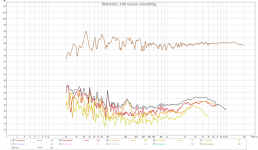
Distortion is okay although it's clear the ND25FA can't keep up with the clean 10F.

Even though the 26W runs higher then I want it to, I consider adding the 26W as a clear upgrade. Not only does it play almost an octave lower but releasing the 22W from pumping low bass and adding 350cm² of SD gives it quite a bit more punch than the 3-way. Integrating a sub gets more and more difficult as the rest of the system becomes more "hi-fi". With the 4-way I don't need the sub for most music except for dubstep and organ music and if I do turn on the sub I have 3 different sources playing 35-80Hz to even out room modes. The sub goes down to about 16Hz in room by the way and has separate DSP control through the inuke3000DSP that powers it.

Integration of the 26W was a lot harder then I expected. There are 2 reasons for this:
1) Getting good measurement data for 30Hz-200Hz in room isn't easy, not for the minphase driver output I need for Rephase nor for checking the result of the crossover.
2) 1023 taps is barely enough for a LR2 at 100Hz, steeper slopes are not possible while maintaining phase linearity.
Due to the above and bafflestep, the 26W is only 20dB down at 1KHz. There are a number of possible solutions for this, none of them really good I think.
1) Put a coil in series with the 26W and go for a hybrid FIR-analogue crossover, seems a bit ballsy but maybe.
2) I can put an additional FIR crossover over left and right channel to decrease the highs overall and boost an equivalent amount in the relevant driver channels. But then I lose bits and resolution, and it won't be the best example of proper gain structure. Gain structure is already pretty bad since I'm using the pre-out of my denon 3806 to feed Najda.
In any case, I'll consider this to be Achilles's first heel 😉


Another weird thing with the 26W integration. At first I had the delays as they should be according to the different acoustic path-lengths and FIR filter delay. It sounded weird, phase didn't seem right and STEP was awful. So I started changing the delay (also tried polarity) for the 26W eventually settling for 425 samples at 48KHz (8.8ms). This is almost the same delay as the tweeter gets due to the shorter FIR filter.

Distortion is okay although it's clear the ND25FA can't keep up with the clean 10F.

Even though the 26W runs higher then I want it to, I consider adding the 26W as a clear upgrade. Not only does it play almost an octave lower but releasing the 22W from pumping low bass and adding 350cm² of SD gives it quite a bit more punch than the 3-way. Integrating a sub gets more and more difficult as the rest of the system becomes more "hi-fi". With the 4-way I don't need the sub for most music except for dubstep and organ music and if I do turn on the sub I have 3 different sources playing 35-80Hz to even out room modes. The sub goes down to about 16Hz in room by the way and has separate DSP control through the inuke3000DSP that powers it.
Last edited:
System description
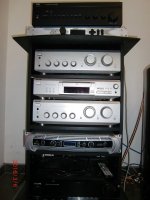
The Tower of Power, from top to bottom:
Nad 356bee, 80W, currently driving the 22W, found 2nd hand for 300€
Najda crossover
Sony TA-FE530R, 90W, driving 10F, 2nd hand 40€
CD player hooked straight to Najda optical SPdiff bypassing Denon 3806
Sony TA-FE520R, 80W, driving tweeter, first amp I bought as a 16 year old with Jamo studio 130 speakers...
Inuke3000DSP, 750W, driving PPSL monster sub on channel 1 and small "10" driver basecube sub" on channel 2 (mostly to give some bass support to outside speakers in summer)
Phillips FA880, 85W, driving 26W, 2nd hand 50€
Lots of different amps, lots of different input sensitivities. Luckily Najda has up to 8dB of analogue gain and I can use the volume control on the amps.

Sitting on PPSL monster sub left to right:
Denon 3806, used as preamp, drives center and back surrounds, outside speakers and does crossover to sub.
B&W HTM600S3 center (should sell and build a better one 😛)
Onkyo 6CD changer, optical SPdiff to Denon
Old dell AMD X2 HTPC, video/audio source via HDMI.

The Tower of Power, from top to bottom:
Nad 356bee, 80W, currently driving the 22W, found 2nd hand for 300€
Najda crossover
Sony TA-FE530R, 90W, driving 10F, 2nd hand 40€
CD player hooked straight to Najda optical SPdiff bypassing Denon 3806
Sony TA-FE520R, 80W, driving tweeter, first amp I bought as a 16 year old with Jamo studio 130 speakers...
Inuke3000DSP, 750W, driving PPSL monster sub on channel 1 and small "10" driver basecube sub" on channel 2 (mostly to give some bass support to outside speakers in summer)
Phillips FA880, 85W, driving 26W, 2nd hand 50€
Lots of different amps, lots of different input sensitivities. Luckily Najda has up to 8dB of analogue gain and I can use the volume control on the amps.

Sitting on PPSL monster sub left to right:
Denon 3806, used as preamp, drives center and back surrounds, outside speakers and does crossover to sub.
B&W HTM600S3 center (should sell and build a better one 😛)
Onkyo 6CD changer, optical SPdiff to Denon
Old dell AMD X2 HTPC, video/audio source via HDMI.
STEP 2.5
Well, it turns out I was a bit of an idiot 😱
Somewhere in the manual it says Najda supports 1023 taps on channel 1,2,3,5,6,7 but only 511 taps on channel 4,8,9,10 (something to do with memory allocation). For some reason I didn't get an error message trying to load 1023 taps in channel 8 and because I usually only measure 1 speaker I didn't see a difference between channel 3 and 4. I have no clue exactly what filter it put on the signal or how it did it (I spent quite some time trying to make new filters and measuring the output, different filters had different output so I didn't realize there was a problem)
I reread the manual and since I only need 1023 taps for the 22W and 26W I could just change channels for all to be well 🙂.
Zonneschimmel 1 - Achilles 0
Well, it turns out I was a bit of an idiot 😱
Somewhere in the manual it says Najda supports 1023 taps on channel 1,2,3,5,6,7 but only 511 taps on channel 4,8,9,10 (something to do with memory allocation). For some reason I didn't get an error message trying to load 1023 taps in channel 8 and because I usually only measure 1 speaker I didn't see a difference between channel 3 and 4. I have no clue exactly what filter it put on the signal or how it did it (I spent quite some time trying to make new filters and measuring the output, different filters had different output so I didn't realize there was a problem)
I reread the manual and since I only need 1023 taps for the 22W and 26W I could just change channels for all to be well 🙂.
Zonneschimmel 1 - Achilles 0
STEP 3
Next up, changing ND25FA-4 for SB26ADC

Nice driver summing, 26W down 35dB at 1KHz 🙂
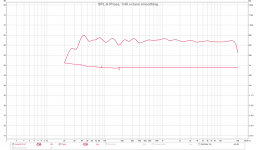
Phase does +-10° from 200-20KHz +-20° from 70-20KHz
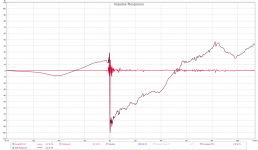
STEP goes out to 5ms
SB26ADC
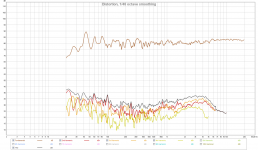
ND25FA
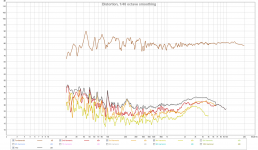
Well distortion drops somewhat at the top end but from memory I can't say it sounds all that different on axis at normal volume levels. It does remain cleaner at elevated levels but I wouldn't listen for more then 5 minutes at those levels. >40° off axis at the dinner table it does sound a lot less muffled then it used to.
On axis I'll have to do a side by side comparison of the 26ADC with the ND25FA to say more, but as it stands now I doubt I would be able to tell the difference at normal volumes.
I honestly expected a bit more going from a 12€ tweeter to a 42€ tweeter but since the ND25FA doesn't like to play below 3KHz I had to buy a new tweeter to be able to cross lower to the SATORI and it's wonderful off axis.
Next up, changing ND25FA-4 for SB26ADC

Nice driver summing, 26W down 35dB at 1KHz 🙂

Phase does +-10° from 200-20KHz +-20° from 70-20KHz

STEP goes out to 5ms
SB26ADC

ND25FA

Well distortion drops somewhat at the top end but from memory I can't say it sounds all that different on axis at normal volume levels. It does remain cleaner at elevated levels but I wouldn't listen for more then 5 minutes at those levels. >40° off axis at the dinner table it does sound a lot less muffled then it used to.
On axis I'll have to do a side by side comparison of the 26ADC with the ND25FA to say more, but as it stands now I doubt I would be able to tell the difference at normal volumes.
I honestly expected a bit more going from a 12€ tweeter to a 42€ tweeter but since the ND25FA doesn't like to play below 3KHz I had to buy a new tweeter to be able to cross lower to the SATORI and it's wonderful off axis.
Last edited:
Well, the FA880 is finally dying on me. The pots are creaking a lot (I cleaned them a few times allready) but since a few days there is some high frequency noise on the right channel. I was thinking about replacing it for a while now and a high quality low watt tweeter amp might be nice so I can use the NAD for the satori and the sony's for the woofers.
Anyone know of any good fully built chipamps?
Anyone know of any good fully built chipamps?
Voicing
Up until this point I always made about a 5dB downward slope as measured from 1m on tweeter axis with 4sample sliding window. This weekend some friends will come over to compare the ND25FA to the SB26ADC and I wanted to also make a flat voicing.
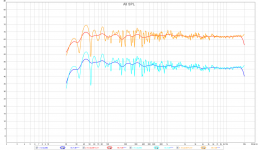
While running distortion measurements I noticed there is about a 2dB increase in highs starting from 5K in comparison to the SPL view.
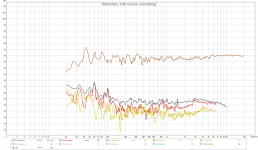
Anyone know why this is?
Up until this point I always made about a 5dB downward slope as measured from 1m on tweeter axis with 4sample sliding window. This weekend some friends will come over to compare the ND25FA to the SB26ADC and I wanted to also make a flat voicing.

While running distortion measurements I noticed there is about a 2dB increase in highs starting from 5K in comparison to the SPL view.

Anyone know why this is?
Sketchup model of the tweeter head with correct dimensions of the styrofoam eggs I bought. I'm going to use an 18mm MDF support, it'll increase the weight and I can make it fit perfectly without having to worry about the fragile styrofoam. Also I can use some small neo magnets to make the head assembly snap on the back of the tweeter baffle. Once the support is finished I can glue on the egg and coat the whole thing with polyester. This is not going the be easy so I got 2 eggs in case I mess it up.
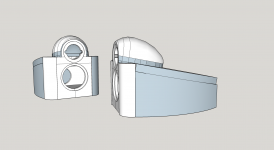

Thanks, let's hope it will sound as good as it looks, otherwise I'll have to start listening with my eyes again 🙂
I think it is due to reflections of your room. Try to add, temporarily, some carpets and pillows to your room or alternatively perform a gated measurement a see the differenceUp until this point I always made about a 5dB downward slope as measured from 1m on tweeter axis with 4sample sliding window. This weekend some friends will come over to compare the ND25FA to the SB26ADC and I wanted to also make a flat voicing.
View attachment 536172
While running distortion measurements I noticed there is about a 2dB increase in highs starting from 5K in comparison to the SPL view.
View attachment 536173
Anyone know why this is?
All measurements are performed at 1m on tweeter axis with the speaker pulled out 2m from the wall with about a 30cm high pile of blankets between mic and speaker.
The top red/orange plot in graph 1 in post 10 is the exact same measurement as the distortion view in graph 2. The orange is 100ms window no smoothing, the red is the same measurement with a 4 sample sliding window. Increasing the window to 500ms does not elevate the treble 2dB like in the distortion plot.
The top red/orange plot in graph 1 in post 10 is the exact same measurement as the distortion view in graph 2. The orange is 100ms window no smoothing, the red is the same measurement with a 4 sample sliding window. Increasing the window to 500ms does not elevate the treble 2dB like in the distortion plot.
Dear Zonneschimmel,All measurements are performed at 1m on tweeter axis with the speaker pulled out 2m from the wall with about a 30cm high pile of blankets between mic and speaker.
The top red/orange plot in graph 1 in post 10 is the exact same measurement as the distortion view in graph 2. The orange is 100ms window no smoothing, the red is the same measurement with a 4 sample sliding window. Increasing the window to 500ms does not elevate the treble 2dB like in the distortion plot.
I'm sorry for my inappropriate post. I have misinterpreted your question and in a rush answered thinking you referred to harmonics ...
Anyway, I congratulate with you for the nice design and the brilliant work done. Like you, I have also recently realized a 4 way active system, but with a different methodological approach (three different boxes, see attached photo below). I finally chosen to use the PC for crossovering and dsp. This allows me to have a lot of calculating capacity (low latency) more precision (65k taps for each way), perform measurements with easy, change setting "on the fly", store my music (4Tb of flac), perform digital room correction, play any kind of disc and so on, with all in one device (my pc). By using a great piece of software like Jriver as player I have also a nice graphical interface and with internet connection availability of lyrics, images, etc etc.
I would like discuss with you about your work I find very interesting and awesome.
I would like discuss with you about your work I find very interesting and awesome.
Attachments
I thought about using a pc as crossover but decided not to go that way (yet). Driver settings, audio stacks and general software troubleshooting gives me a big headache but I'm very interested to learn how you did it 🙂. What drivers are you using?
- Status
- Not open for further replies.
- Home
- Loudspeakers
- Multi-Way
- Achilles FIR 4-way

